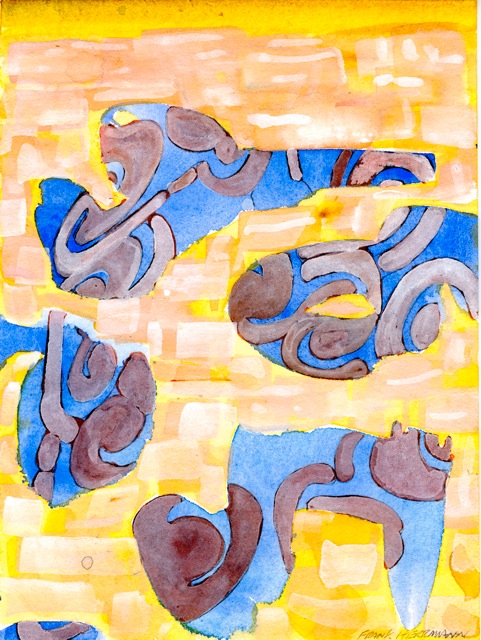Small Packages/Good Things
by Fran Watson
Motif, Mantra & Mystery
Small works by Frank Herrmann, Kim Krause and Eric Standley
Marta Hewett Gallery
Jun 28 – August 24, 2013
Artists need to think their way up. Great huge works don’t simply happen. They follow many little ideas which one day culminate in a masterpiece…. sometimes. Often the public doesn’t get a glimpse of this visible path to art, but “Motif, Mantra and Mystery” at Marta Hewett takes two of her finest artists, Frank Herrmann and Kim Krause, and showcases their thought processes as seen in small, even tiny, working sketches. As both conceded , there’s something liberating about just sitting at a desk allowing ideas to come and go without commitment.
Personal style comes through no matter what. Both men build on previous work, themes which are not , and may never be, completely finished. Herrmann is still deeply interested in the Asmat people. He combines graphite drawings, watercolor and acrylic, and in some instances, collage. It hardly seems as if there could be enough room in these 5” x 7” paper pieces which explain themselves with titles like “Thinking”, numbered 3 through 6 for all of this, yet they convey a cohesive creative message.
Herrmann has been mentally involved with the Asmat culture of New Guinea for some years. They are a tribe which had little or no contact with the civilized world until about 70 years ago. Primitive customs, art, and their own beliefs remain today even as our modern world creeps in, nearly promising the ultimate passing of even this last precious individuality. Symbols related to their deep respect for their ancestors, are most often reproduced in wood carvings. Utensils, vestments, and ritual accoutrements use these symbols to keep their history alive, and , as is all art, are a method of communication.
These shapes become Herrmann’s own new landscapes of art, ever changing in his hands. Most of the backgrounds in his work are alive with interwoven symbols, sometimes so faintly defined that the activity is difficult to notice. The “Thinking” paintings, go from expected drawing materials, to unrecognizable odd shapes of heavily painted collage pieces, not easily found among so many textures. Textures are assuredly his forte. The artist mixes smoothly floating objects, with harsh, earthy contrast, bringing all to an amicable conclusion.
“Motif”s, also numbered one through four, are gentler works, relying on watercolor to carry the symbols which dominate his concept. Those interwoven backgrounds, mentioned above, are delicately formed behind the dominant abstract shapes which float placidly on the surfaces. Perhaps the deep reds and browns seen in Herrmann’s works reflect the tribe’s violent past as headhunters. These quieter pieces may then reflect a deeper, more spiritual facet of Asmat existence.
Kim Krause works his way into larger formats a similar manner. He has chosen a ribbon-like motif which may be seen in his exhibited works elsewhere in the gallery and expanded the image to a mandala-like theme, softly but deeply colored in pastel shades. An historic theme also inspires his work. The ancient (3,000 year old) Eleusinian Mysteries opened a door to Krause’s creativity for a modern investigation. As an initiation rite in the Cult of Demeter, it’s secrets remain undiscovered yet today. Initiates were driven to a frenzy of excitement, then marched to the of Eleusis where they witnessed some object or event which many claimed changed the way they viewed the universe.
Krause paints recurring circles of various sizes, curving and swirling into each other, much as the universe itself bends and winds through space and time. Faded pieces of arcs add to the mystery. Painting out marks while leaving their pale traces is important in all of these “ Eleusinian Mysteries”. Through them Krause creates his own mysteries in forms that may have once been firmly placed, only to be discarded.
The most intriguing of his mysteries are a set of four watercolors. Simply by dint of the medium, changes are difficult to completely eradicate, making the obvious images even more complicated. This pentimento renders the feeling of past events through its ghostly transparency, exacerbating an aura of mystery .
Amazing cut paper constructions by Eric Standley round out this “small” show perfectly. Here the mandala takes on a dimension and unbelievable intricacy in something completely different from painting.
My only criticism is that the show isn’t big enough. This idea alone, the beginnings of art, is worthy of much more. Collections of artists’ thoughts and progression are a fascinating ingredient of art, allowing the public to peer inside the magic of creativity. Bring it on.







September 21st, 2013at 10:06 am(#)
Great review of two terrific artists. Bravo to all.